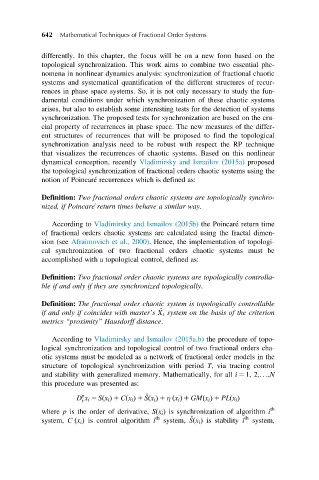Page 671 - Mathematical Techniques of Fractional Order Systems
P. 671
642 Mathematical Techniques of Fractional Order Systems
differently. In this chapter, the focus will be on a new form based on the
topological synchronization. This work aims to combine two essential phe-
nomena in nonlinear dynamics analysis: synchronization of fractional chaotic
systems and systematical quantification of the different structures of recur-
rences in phase space systems. So, it is not only necessary to study the fun-
damental conditions under which synchronization of these chaotic systems
arises, but also to establish some interesting tests for the detection of systems
synchronization. The proposed tests for synchronization are based on the cru-
cial property of recurrences in phase space. The new measures of the differ-
ent structures of recurrences that will be proposed to find the topological
synchronization analysis need to be robust with respect the RP technique
that visualizes the recurrences of chaotic systems. Based on this nonlinear
dynamical conception, recently Vladimirsky and Ismailov (2015a) proposed
the topological synchronization of fractional orders chaotic systems using the
notion of Poincare ´ recurrences which is defined as:
Definition: Two fractional orders chaotic systems are topologically synchro-
nized, if Poincare ´ return times behave a similar way.
According to Vladimirsky and Ismailov (2015b) the Poincare ´ return time
of fractional orders chaotic systems are calculated using the fractal dimen-
sion (see Afraimovich et al., 2000). Hence, the implementation of topologi-
cal synchronization of two fractional orders chaotic systems must be
accomplished with a topological control, defined as:
Definition: Two fractional order chaotic systems are topologically controlla-
ble if and only if they are synchronized topologically.
Definition: The fractional order chaotic system is topologically controllable
^
if and only if coincides with master’s X t system on the basis of the criterion
metrics “proximity” Hausdorff distance.
According to Vladimirsky and Ismailov (2015a,b) the procedure of topo-
logical synchronization and topological control of two fractional orders cha-
otic systems must be modeled as a network of fractional order models in the
structure of topological synchronization with period T, via tracing control
and stability with generalized memory. Mathematically, for all i 5 1, 2,...,N
this procedure was presented as:
p ^
D x i 5 Sðx i Þ 1 Cðx i Þ 1 Sðx i Þ 1 η ðx i Þ 1 GMðx i Þ 1 PLðx i Þ
t
where p is the order of derivative, Sðx i Þ is synchronization of algorithm i th
^
system, C ðx i Þ is control algorithm i th system, Sðx i Þ is stability i th system,

